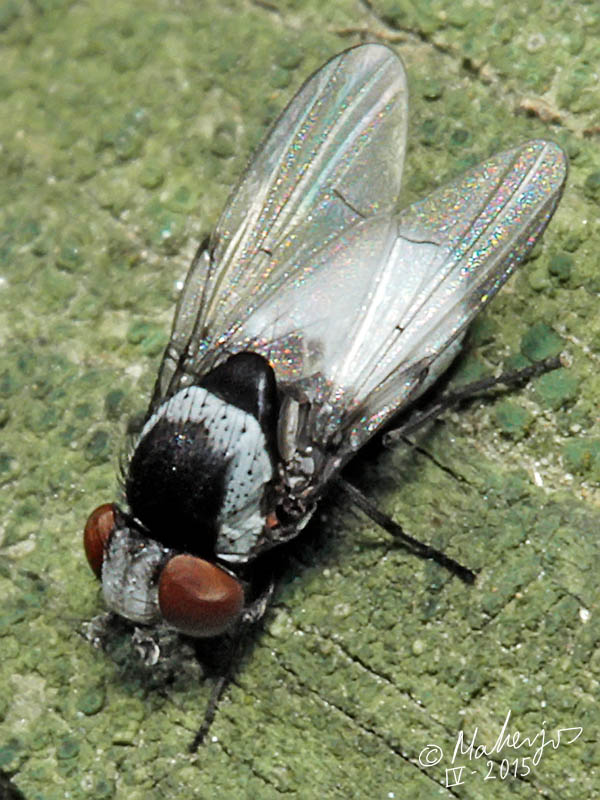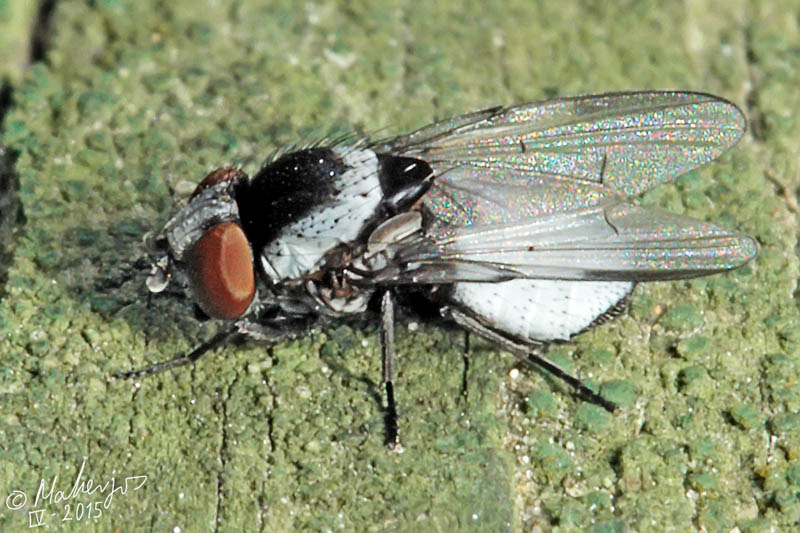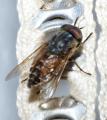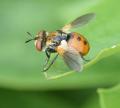Diptera.info :: Identification queries :: Diptera (adults)
Who is here? 1 guest(s)
|
Milichia canariensis, male.
|
|
| Maherjos |
Posted on 19-04-2015 20:20
|
|
Member Location: Motril (Granada) España Posts: 2342 Joined: 02.09.09 |
Photograph taken on April 18 2015, in the wetlands of the Suárez Pond in Motril, Granada, Spain. Immediate area of the Mediterranean coast. Apparent size with wings, about 4-6 mm Appreciate your cooperation for identification. Maherjos attached the following image:  [132.32Kb] Edited by Maherjos on 08-10-2015 18:47 |
|
|
|
| Maherjos |
Posted on 19-04-2015 20:24
|
|
Member Location: Motril (Granada) España Posts: 2342 Joined: 02.09.09 |
.
Maherjos attached the following image:  [123.29Kb] |
|
|
|
| Paul Beuk |
Posted on 27-04-2015 13:24
|
|
Super Administrator Location: Netherlands Posts: 19225 Joined: 11.05.04 |
If I understand Carles Tolrá (2009; http://www.hetero...05-110.pdf) correctly, the colour pattern is not sufficient to distinguishe between canariensis and speciosa. The former is only recorded from the Canary Ilsnads and Turkey and, as yet, not from the Iberian Peninsula.
Edited by Paul Beuk on 27-04-2015 13:25 Paul - - - - Paul Beuk on https://diptera.info |
| Maherjos |
Posted on 27-04-2015 16:04
|
|
Member Location: Motril (Granada) España Posts: 2342 Joined: 02.09.09 |
Paul Beuk wrote: If I understand Carles Tolrá (2009; http://www.hetero...05-110.pdf) correctly, the colour pattern is not sufficient to distinguishe between canariensis and speciosa. The former is only recorded from the Canary Ilsnads and Turkey and, as yet, not from the Iberian Peninsula. Hi Paul. As you know, I'm just a fan of Diptera, who have come through photography. So always ask and am very grateful data, information and knowledge provided by experts you. If I thought that the fly of my photographs could be Milichia canariensis, it is only because about two years ago in the same place in Spain, -Charca Suarez in Motril, photograph these other two copies, male and female, who as such were confirmed by Irina Brake specialist. http://www.dipter...d_id=54614 http://www.dipter...d_id=54615 And to your request and were uploaded to the Gallery: http://www.dipter...to_id=8964 http://www.dipter...to_id=8962 After this meeting, 25/04/2015 day in the same place, went to photograph a female with the same. And the day 26/04/2005 I returned to photograph another male. These last pictures I have not yet had a chance to process them and upload them, but as soon as it can go up to the same post. When I can, I will process and will upload the rest of the pictures. And as soon as I get communicate with the specialist milichia, I think we will leave doubts. Kind regards from southern Spain. José Marín Edited by Maherjos on 27-04-2015 16:05 |
|
|
|
| Paul Beuk |
Posted on 27-04-2015 18:43
|
|
Super Administrator Location: Netherlands Posts: 19225 Joined: 11.05.04 |
If youy have specimens, we can look at the right structures after preparation of the abdomen.
Paul - - - - Paul Beuk on https://diptera.info |
| Maherjos |
Posted on 27-04-2015 20:43
|
|
Member Location: Motril (Granada) España Posts: 2342 Joined: 02.09.09 |
Paul Beuk wrote: If youy have specimens, we can look at the right structures after preparation of the abdomen. Is the male or female needed? Would you do personally preparations and pictures of genitalia? I want to learn. I have a microscope and take photographs with a microscope. But I have no training or experience in photographs of the genitalia. I have to learn. Greetings José Marín |
|
|
|
| Paul Beuk |
Posted on 28-04-2015 17:25
|
|
Super Administrator Location: Netherlands Posts: 19225 Joined: 11.05.04 |
Both could give the necessary details, check the pictures in the linked publication. I personally probably would do simple preparations to confirm species (so not resulting in those well stuctured images). Abdomen (or just the tip if it is a male) in lactic acid, few seconds in micro wave (twice, a minute or so apart), and then transfer to alcohol (if it may swell) or glycerine (should not swell that much). Others will prefer other methods... Paul - - - - Paul Beuk on https://diptera.info |
| Maherjos |
Posted on 28-04-2015 20:25
|
|
Member Location: Motril (Granada) España Posts: 2342 Joined: 02.09.09 |
Paul Beuk wrote: Both could give the necessary details, check the pictures in the linked publication. I personally probably would do simple preparations to confirm species (so not resulting in those well stuctured images). Abdomen (or just the tip if it is a male) in lactic acid, few seconds in micro wave (twice, a minute or so apart), and then transfer to alcohol (if it may swell) or glycerine (should not swell that much). Others will prefer other methods... Indeed, it is quite complicated ...  Soon I will contact you privately. Kind regards Jose Marin. |
|
|
|
| ibrake |
Posted on 19-05-2015 17:09
|
|
Member Location: Posts: 64 Joined: 03.03.08 |
Hi, I would identify this fly as Milichia canariensis based on the colour, but the species is certainly closely related to Milichia speciosa. A look at all the material of both species (and M. decora) with a study of the variation of colour and shape would help... Irina |
| Paul Beuk |
Posted on 08-10-2015 13:28
|
|
Super Administrator Location: Netherlands Posts: 19225 Joined: 11.05.04 |
I tentatively would say this is canariensis after examination of the genitalia. Unfortunately, the images provided by Carles-Tolrá, when he re-instated it as valid species, are not quite comparable for both species. Firstly, the images of speciosa proper are much darker than those of canariensis which makes it difficult to discern the different structures very well. Secondly, the image of the speciosa genitalia supposedly in ventral view, is much more posteriorly directed than that the corresponding image for canariensis. If I were to give orientation (anatomically; so as if the cerci were located posteriorly), canariensis would have images in posteroventral and anteroventral directions (90 degree difference); speciosa would have them in posteroventral and ventral directions (45 degree difference). Most structures I can see I can match in the images for canarienses (including the apparently smaller surstyli, that remain well separated) but I cannot say they might not match that of speciosa. I need to get my hands on a true speciosa for dissection... By the way, what was the exact date these specimens were collected (and were they collected the same day; one headless, the other complete)? Edited by Paul Beuk on 08-10-2015 13:29 Paul - - - - Paul Beuk on https://diptera.info |
| Maherjos |
Posted on 08-10-2015 18:46
|
|
Member Location: Motril (Granada) España Posts: 2342 Joined: 02.09.09 |
Paul Beuk wrote: I tentatively would say this is canariensis after examination of the genitalia. Unfortunately, the images provided by Carles-Tolrá, when he re-instated it as valid species, are not quite comparable for both species. Firstly, the images of speciosa proper are much darker than those of canariensis which makes it difficult to discern the different structures very well. Secondly, the image of the speciosa genitalia supposedly in ventral view, is much more posteriorly directed than that the corresponding image for canariensis. If I were to give orientation (anatomically; so as if the cerci were located posteriorly), canariensis would have images in posteroventral and anteroventral directions (90 degree difference); speciosa would have them in posteroventral and ventral directions (45 degree difference). Most structures I can see I can match in the images for canarienses (including the apparently smaller surstyli, that remain well separated) but I cannot say they might not match that of speciosa. I need to get my hands on a true speciosa for dissection... By the way, what was the exact date these specimens were collected (and were they collected the same day; one headless, the other complete)? Male, 2015/04/18. Female 2015/04/25. From what I've seen photographs of Milichia speciosa, none has been taken on the Mediterranean coast of southern Spain. In the photographs I have seen, of M. speciosa, patches of their wings are larger and more darken her wings. http://www.biodiv...27857.html I guess, what you could deduce that the copies sent, coupled with the opinion of Irina in principle be reasonable and fairly correct proposal Milichia canariensis identification. Thanks for the detailed and thorough study that you have done. Best wishes, Jose Marin. |
|
|
|
| Paul Beuk |
Posted on 08-10-2015 18:48
|
|
Super Administrator Location: Netherlands Posts: 19225 Joined: 11.05.04 |
Both specimens you sent were males...
Paul - - - - Paul Beuk on https://diptera.info |
| Maherjos |
Posted on 08-10-2015 18:54
|
|
Member Location: Motril (Granada) España Posts: 2342 Joined: 02.09.09 |
Paul Beuk wrote: Both specimens you sent were males... Ah !. Error on my part ...  Even then might remain stored any female ... Would it help to clarify the issue? |
|
|
|
| Paul Beuk |
Posted on 09-10-2015 08:45
|
|
Super Administrator Location: Netherlands Posts: 19225 Joined: 11.05.04 |
Apparently the female sternites are structurally different in both species so that would help.
Paul - - - - Paul Beuk on https://diptera.info |
| Maherjos |
Posted on 09-10-2015 08:57
|
|
Member Location: Motril (Granada) España Posts: 2342 Joined: 02.09.09 |
Paul Beuk wrote: Apparently the female sternites are structurally different in both species so that would help. I seek and you send it. To see if it is possible to dispel any doubts. |
|
|
|
| Paul Beuk |
Posted on 05-01-2016 16:23
|
|
Super Administrator Location: Netherlands Posts: 19225 Joined: 11.05.04 |
I received the female today and based on the sternites it should be speciosa: there is only a very limited increase in the size of the tergites from segment 3 to 5. Also, If the images given by Carles-Tolrá are followed, there are some differences in the setae on the sternites and in the whole sequence of sternites, too, sternite 2 is relatively smaller in canariensis.
Paul - - - - Paul Beuk on https://diptera.info |
| Nacho Cabellos |
Posted on 16-11-2023 18:13
|
|
Member Location: Spain Posts: 1173 Joined: 27.09.09 |
i'm very interested in Milichidae and, after reading the literature I found about theese family, I came to this post. If I understood correctly, there is no any confirmation about the presence of M. canariensis in the Iberian Peninsula, right? The only sign of theese presence consists in an identification, based on a color pattern, besides posterior identifications bassed on that one; pattern that, according to a poblication of M.C. Tolra, is not enough to distinguish both species bacause exists individuals of M.speciosa that exhibing that pattern. Could you confirm if there is any change on this topic? Thanks a lot in advance!! Edited by Nacho Cabellos on 16-11-2023 18:14 |
|
|
|
| Jump to Forum: |














 but don't see the image in the post.
but don't see the image in the post.
